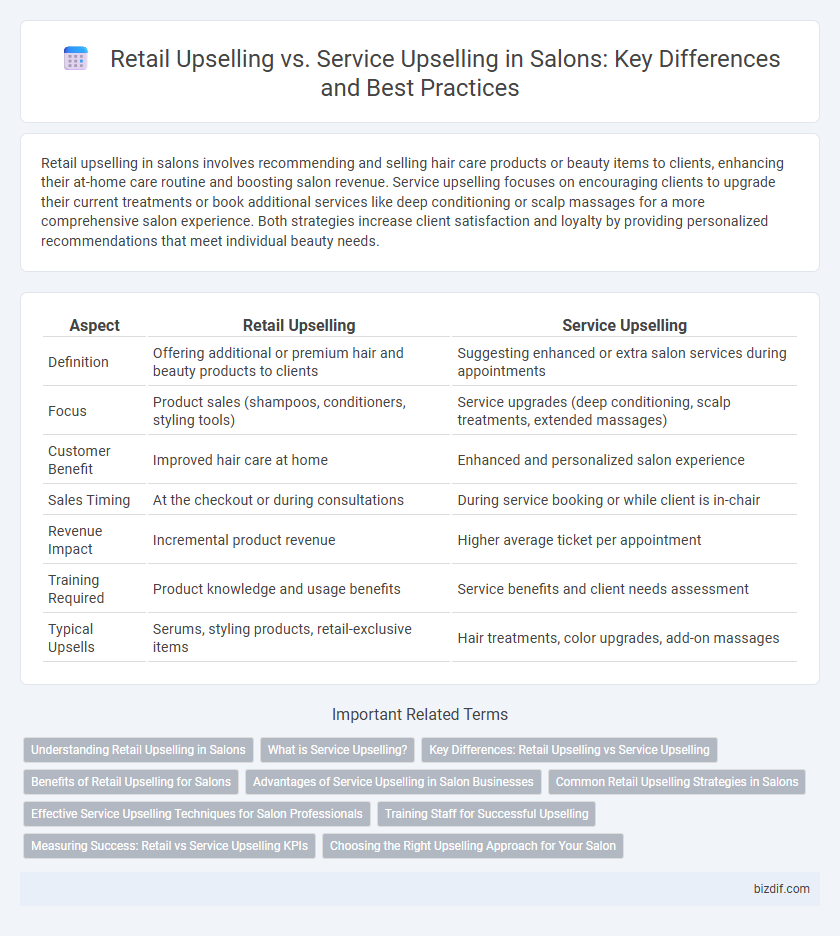Retail upselling in salons involves recommending and selling hair care products or beauty items to clients, enhancing their at-home care routine and boosting salon revenue. Service upselling focuses on encouraging clients to upgrade their current treatments or book additional services like deep conditioning or scalp massages for a more comprehensive salon experience. Both strategies increase client satisfaction and loyalty by providing personalized recommendations that meet individual beauty needs.
Table of Comparison
| Aspect | Retail Upselling | Service Upselling |
|---|---|---|
| Definition | Offering additional or premium hair and beauty products to clients | Suggesting enhanced or extra salon services during appointments |
| Focus | Product sales (shampoos, conditioners, styling tools) | Service upgrades (deep conditioning, scalp treatments, extended massages) |
| Customer Benefit | Improved hair care at home | Enhanced and personalized salon experience |
| Sales Timing | At the checkout or during consultations | During service booking or while client is in-chair |
| Revenue Impact | Incremental product revenue | Higher average ticket per appointment |
| Training Required | Product knowledge and usage benefits | Service benefits and client needs assessment |
| Typical Upsells | Serums, styling products, retail-exclusive items | Hair treatments, color upgrades, add-on massages |
Understanding Retail Upselling in Salons
Retail upselling in salons involves promoting professional hair care products and beauty essentials directly to clients during their visit, enhancing the overall salon experience and boosting revenue. Understanding client needs and product benefits allows stylists to recommend customized solutions like shampoos, conditioners, or styling tools that complement their service. This targeted approach increases product sales while fostering customer loyalty through expert advice and tailored recommendations.
What is Service Upselling?
Service upselling in a salon involves encouraging clients to upgrade or add premium treatments and enhancements during their appointment, such as deep conditioning, scalp massages, or advanced styling options. This strategy focuses on enhancing the overall client experience and increasing the average transaction value by recommending professional services tailored to individual needs. Unlike retail upselling, which centers on product sales, service upselling emphasizes expert care and personalized service enhancements to boost customer satisfaction and loyalty.
Key Differences: Retail Upselling vs Service Upselling
Retail upselling in salons emphasizes promoting product sales such as shampoos, conditioners, and styling tools to clients, often enhancing the at-home care experience and increasing salon revenue per visit. Service upselling focuses on encouraging clients to upgrade or add complementary treatments like deep conditioning, scalp massages, or advanced hair coloring techniques, aiming to enhance the immediate salon experience and client satisfaction. Key differences include the tangible nature of retail products versus intangible service enhancements and the distinct strategies for demonstrating value, with retail relying on product benefits and service upselling emphasizing experiential improvements.
Benefits of Retail Upselling for Salons
Retail upselling in salons boosts revenue by encouraging clients to purchase professional haircare and beauty products used during their appointments, enhancing their at-home results. This strategy strengthens client loyalty and trust by providing personalized product recommendations tailored to individual hair and skin needs. Offering high-quality retail products also differentiates the salon experience, increasing overall customer satisfaction and retention.
Advantages of Service Upselling in Salon Businesses
Service upselling in salon businesses enhances client satisfaction by offering personalized treatments that address specific beauty needs, leading to higher retention rates and increased revenue per appointment. It builds trust and loyalty through expert recommendations, encouraging repeat visits and long-term engagement. Compared to retail upselling, service upselling leverages the professional expertise of salon staff, creating a more compelling value proposition that drives sustainable growth.
Common Retail Upselling Strategies in Salons
Common retail upselling strategies in salons include recommending complementary hair care products that enhance the results of a service, such as shampoos, conditioners, and styling tools specifically tailored to the client's hair type. Stylists often suggest premium or salon-exclusive brands to elevate the client's at-home hair care routine while increasing product sales. Offering bundles or discounts on multiple retail items encourages clients to purchase more, boosting overall salon revenue.
Effective Service Upselling Techniques for Salon Professionals
Service upselling in salons focuses on enhancing the client's experience by recommending complementary treatments like deep conditioning or scalp massages during appointments. Effective techniques include personalized consultations that identify client needs, clear communication of benefits, and showcasing results through before-and-after visuals. Training salon professionals in active listening and product knowledge significantly boosts confidence in suggesting upgrades and increases overall client satisfaction and revenue.
Training Staff for Successful Upselling
Training staff in retail upselling enhances product knowledge and communication skills, enabling them to recommend complementary products effectively during client interactions. Service upselling training focuses on educating employees about tailored treatment options and the benefits of premium services, increasing the likelihood of clients opting for enhanced experiences. Combining both approaches through targeted staff development boosts overall revenue and improves client satisfaction in salon environments.
Measuring Success: Retail vs Service Upselling KPIs
Measuring success in retail upselling involves tracking key performance indicators (KPIs) such as average transaction value, product attach rate, and inventory turnover, which directly reflect client purchasing behavior and product demand. Service upselling KPIs focus on metrics like service upgrade frequency, client retention rate, and average service ticket size to gauge how effectively enhanced services drive increased revenue and customer loyalty. Comparing these KPIs helps salon managers optimize sales strategies by balancing product sales growth with premium service adoption.
Choosing the Right Upselling Approach for Your Salon
Retail upselling in salons focuses on recommending hair care products, styling tools, and beauty essentials that complement customer services, enhancing client satisfaction and boosting revenue per visit. Service upselling involves suggesting premium treatments, add-on services, or package upgrades tailored to the client's needs, increasing the overall value and improving the salon experience. Selecting the right upselling approach depends on understanding client preferences, analyzing purchase behavior, and aligning offers with both individual customer goals and the salon's profitability strategies.
Retail Upselling vs Service Upselling Infographic

 bizdif.com
bizdif.com